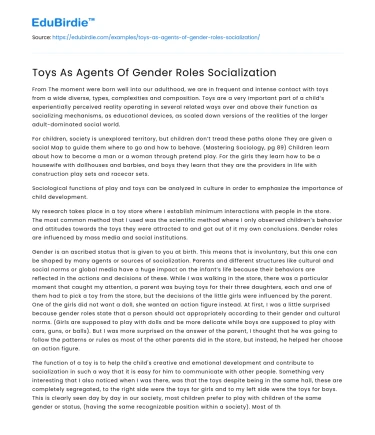From The moment were born well into our adulthood, we are in frequent and intense contact with toys from a wide diverse, types, complexities and composition. Toys are a very important part of a child’s experientially perceived reality operating in several related ways over and above their function as socializing mechanisms, as educational devices, as scaled down versions of the realities of the larger adult-dominated social world.
For children, society is unexplored territory, but children don’t tread these paths alone They are given a social Map to guide them where to go and how to behave. (Mastering Sociology, pg 89) Children learn about how to become a man or a woman through pretend play. For the girls they learn how to be a housewife with dollhouses and barbies, and boys they learn that they are the providers in life with construction play sets and racecar sets.
Save your time!
We can take care of your essay
- Proper editing and formatting
- Free revision, title page, and bibliography
- Flexible prices and money-back guarantee
Sociological functions of play and toys can be analyzed in culture in order to emphasize the importance of child development.
My research takes place in a toy store where I establish minimum interactions with people in the store. The most common method that I used was the scientific method where I only observed children’s behavior and attitudes towards the toys they were attracted to and got out of it my own conclusions. Gender roles are influenced by mass media and social institutions.
Gender is an ascribed status that is given to you at birth. This means that is involuntary, but this one can be shaped by many agents or sources of socialization. Parents and different structures like cultural and social norms or global media have a huge impact on the infant’s life because their behaviors are reflected in the actions and decisions of these. While I was walking in the store, there was a particular moment that caught my attention, a parent was buying toys for their three daughters, each and one of them had to pick a toy from the store, but the decisions of the little girls were influenced by the parent. One of the girls did not want a doll, she wanted an action figure instead. At first, I was a little surprised because gender roles state that a person should act appropriately according to their gender and cultural norms. (Girls are supposed to play with dolls and be more delicate while boys are supposed to play with cars, guns, or balls). But I was more surprised on the answer of the parent, I thought that he was going to follow the patterns or rules as most of the other parents did in the store, but instead, he helped her choose an action figure.
The function of a toy is to help the child's creative and emotional development and contribute to socialization in such a way that it is easy for him to communicate with other people. Something very interesting that I also noticed when I was there, was that the toys despite being in the same hall, these are completely segregated, to the right side were the toys for girls and to my left side were the toys for boys. This is clearly seen day by day in our society, most children prefer to play with children of the same gender or status, (having the same recognizable position within a society). Most of the toys had on their covers a specific gender, for example, kitchen toys, or houses only had the figure of a girl, and Nerf weapons, had the figure of a boy, this does not mean that all toys support gender exclusion. Mattel toys and WWE action figures showed gender inclusion since they not only had dolls that refer to girls but also male figures.
Finally, the toys of neutral gender did not have the highest consumption, since they are for ages 3 to 6 years, these toys can be blocks, wooden toys, coloring books, etc. However, bicycles, skateboards, and scooters can be considered neutral toys, but they lose that value when they are given a characteristic belonging to the male or female gender, these characteristics can be identified by color.
Toy companies use market strategies that facilitate the interest of their products, advertising through television ads, social networks, and newspapers, among others. They are forms of advertising, this influence thousands of people in this case children. Girls' toys have striking and strong colors that make the girls get their attention and acquire the products, these colors can be pink, yellow, purple among others; while boys prefer that their toys have neutral colors such as black, gray, white, red, blue, etc.
Gender role happens when people are taught cultural roles based on their sex. Boys and girls are treated differently by people in their own environments like parents, siblings, and caregivers; Toys are a key factor in gender socialization. Gender roles can also contribute to gender inequality as one group finds itself blocked (segregated) from participation or access to some facilities, occupation or activity.






 Stuck on your essay?
Stuck on your essay?

